[English] 日本語
 Yorodumi
Yorodumi- PDB-1dgi: Cryo-EM structure of human poliovirus(serotype 1)complexed with t... -
+ Open data
Open data
- Basic information
Basic information
| Entry | Database: PDB / ID: 1dgi | ||||||
|---|---|---|---|---|---|---|---|
| Title | Cryo-EM structure of human poliovirus(serotype 1)complexed with three domain CD155 | ||||||
 Components Components |
| ||||||
 Keywords Keywords | Virus/Receptor /  CD155 / PVR / CD155 / PVR /  HUMAN POLIOVIRUS / POLIOVIRUS-RECEPTOR COMPLEX / Icosahedral virus / Virus-Receptor COMPLEX HUMAN POLIOVIRUS / POLIOVIRUS-RECEPTOR COMPLEX / Icosahedral virus / Virus-Receptor COMPLEX | ||||||
| Function / homology |  Function and homology information Function and homology informationsusceptibility to T cell mediated cytotoxicity / susceptibility to natural killer cell mediated cytotoxicity / Nectin/Necl trans heterodimerization / positive regulation of natural killer cell mediated cytotoxicity directed against tumor cell target / symbiont-mediated suppression of host translation initiation / heterophilic cell-cell adhesion via plasma membrane cell adhesion molecules / positive regulation of natural killer cell mediated cytotoxicity / homophilic cell adhesion via plasma membrane adhesion molecules / symbiont-mediated suppression of host cytoplasmic pattern recognition receptor signaling pathway via inhibition of MDA-5 activity / symbiont-mediated suppression of host cytoplasmic pattern recognition receptor signaling pathway via inhibition of RIG-I activity ...susceptibility to T cell mediated cytotoxicity / susceptibility to natural killer cell mediated cytotoxicity / Nectin/Necl trans heterodimerization / positive regulation of natural killer cell mediated cytotoxicity directed against tumor cell target / symbiont-mediated suppression of host translation initiation / heterophilic cell-cell adhesion via plasma membrane cell adhesion molecules / positive regulation of natural killer cell mediated cytotoxicity / homophilic cell adhesion via plasma membrane adhesion molecules / symbiont-mediated suppression of host cytoplasmic pattern recognition receptor signaling pathway via inhibition of MDA-5 activity / symbiont-mediated suppression of host cytoplasmic pattern recognition receptor signaling pathway via inhibition of RIG-I activity /  picornain 2A / symbiont-mediated suppression of host cytoplasmic pattern recognition receptor signaling pathway via inhibition of MAVS activity / symbiont-mediated suppression of host mRNA export from nucleus / symbiont genome entry into host cell via pore formation in plasma membrane / picornain 2A / symbiont-mediated suppression of host cytoplasmic pattern recognition receptor signaling pathway via inhibition of MAVS activity / symbiont-mediated suppression of host mRNA export from nucleus / symbiont genome entry into host cell via pore formation in plasma membrane /  cell adhesion molecule binding / ribonucleoside triphosphate phosphatase activity / cell adhesion molecule binding / ribonucleoside triphosphate phosphatase activity /  picornain 3C / T=pseudo3 icosahedral viral capsid / host cell cytoplasmic vesicle membrane / picornain 3C / T=pseudo3 icosahedral viral capsid / host cell cytoplasmic vesicle membrane /  adherens junction / endocytosis involved in viral entry into host cell / adherens junction / endocytosis involved in viral entry into host cell /  : / Immunoregulatory interactions between a Lymphoid and a non-Lymphoid cell / nucleoside-triphosphate phosphatase / protein complex oligomerization / virus receptor activity / : / Immunoregulatory interactions between a Lymphoid and a non-Lymphoid cell / nucleoside-triphosphate phosphatase / protein complex oligomerization / virus receptor activity /  signaling receptor activity / monoatomic ion channel activity / signaling receptor activity / monoatomic ion channel activity /  RNA helicase activity / induction by virus of host autophagy / RNA helicase activity / induction by virus of host autophagy /  RNA-directed RNA polymerase / symbiont-mediated suppression of host gene expression / viral RNA genome replication / cysteine-type endopeptidase activity / RNA-directed RNA polymerase / symbiont-mediated suppression of host gene expression / viral RNA genome replication / cysteine-type endopeptidase activity /  RNA-dependent RNA polymerase activity / RNA-dependent RNA polymerase activity /  focal adhesion / DNA-templated transcription / host cell nucleus / structural molecule activity / virion attachment to host cell / focal adhesion / DNA-templated transcription / host cell nucleus / structural molecule activity / virion attachment to host cell /  cell surface / cell surface /  proteolysis / proteolysis /  extracellular space / extracellular space /  RNA binding / RNA binding /  ATP binding / ATP binding /  membrane / membrane /  metal ion binding / metal ion binding /  plasma membrane / plasma membrane /  cytoplasm cytoplasmSimilarity search - Function | ||||||
| Biological species |   Homo sapiens (human) Homo sapiens (human)  Human poliovirus 1 Human poliovirus 1 | ||||||
| Method |  ELECTRON MICROSCOPY / ELECTRON MICROSCOPY /  single particle reconstruction / single particle reconstruction /  cryo EM / Resolution: 22 Å cryo EM / Resolution: 22 Å | ||||||
 Authors Authors | He, Y. / Bowman, V.D. / Mueller, S. / Bator, C.M. / Bella, J. / Peng, X. / Baker, T.S. / Wimmer, E. / Kuhn, R.J. / Rossmann, M.G. | ||||||
 Citation Citation |  Journal: Proc Natl Acad Sci U S A / Year: 2000 Journal: Proc Natl Acad Sci U S A / Year: 2000Title: Interaction of the poliovirus receptor with poliovirus. Authors: Y He / V D Bowman / S Mueller / C M Bator / J Bella / X Peng / T S Baker / E Wimmer / R J Kuhn / M G Rossmann /  Abstract: The structure of the extracellular, three-domain poliovirus receptor (CD155) complexed with poliovirus (serotype 1) has been determined to 22-A resolution by means of cryo-electron microscopy and ...The structure of the extracellular, three-domain poliovirus receptor (CD155) complexed with poliovirus (serotype 1) has been determined to 22-A resolution by means of cryo-electron microscopy and three-dimensional image-reconstruction techniques. Density corresponding to the receptor was isolated in a difference electron density map and fitted with known structures, homologous to those of the three individual CD155 Ig-like domains. The fit was confirmed by the location of carbohydrate moieties in the CD155 glycoprotein, the conserved properties of elbow angles in the structures of cell surface molecules with Ig-like folds, and the concordance with prior results of CD155 and poliovirus mutagenesis. CD155 binds in the poliovirus "canyon" and has a footprint similar to that of the intercellular adhesion molecule-1 receptor on human rhinoviruses. However, the orientation of the long, slender CD155 molecule relative to the poliovirus surface is quite different from the orientation of intercellular adhesion molecule-1 on rhinoviruses. In addition, the residues that provide specificity of recognition differ for the two receptors. The principal feature of receptor binding common to these two picornaviruses is the site in the canyon at which binding occurs. This site may be a trigger for initiation of the subsequent uncoating step required for viral infection. #1:  Journal: Proc.Natl.Acad.Sci.USA / Year: 1998 Journal: Proc.Natl.Acad.Sci.USA / Year: 1998Title: The Structure of the Two Amino-Terminal Domain of Human Icam-1 Suggests How It Functions as a Rhinovirus Receptor and as an Lfa-1 Integrin Ligand Authors: Bella, J. / Kolatkar, P. / Marlor, C.W. / Greve, J. / Rossmann, M.G. #2:  Journal: Science / Year: 1985 Journal: Science / Year: 1985Title: Three-Dimensional Structure of Poliovirus at 2.9A Resolution Authors: Hogle, J. / Chow, M. / Filman, D.J. | ||||||
| History |
|
- Structure visualization
Structure visualization
| Movie |
 Movie viewer Movie viewer |
|---|---|
| Structure viewer | Molecule:  Molmil Molmil Jmol/JSmol Jmol/JSmol |
- Downloads & links
Downloads & links
- Download
Download
| PDBx/mmCIF format |  1dgi.cif.gz 1dgi.cif.gz | 61 KB | Display |  PDBx/mmCIF format PDBx/mmCIF format |
|---|---|---|---|---|
| PDB format |  pdb1dgi.ent.gz pdb1dgi.ent.gz | 30.4 KB | Display |  PDB format PDB format |
| PDBx/mmJSON format |  1dgi.json.gz 1dgi.json.gz | Tree view |  PDBx/mmJSON format PDBx/mmJSON format | |
| Others |  Other downloads Other downloads |
-Validation report
| Arichive directory |  https://data.pdbj.org/pub/pdb/validation_reports/dg/1dgi https://data.pdbj.org/pub/pdb/validation_reports/dg/1dgi ftp://data.pdbj.org/pub/pdb/validation_reports/dg/1dgi ftp://data.pdbj.org/pub/pdb/validation_reports/dg/1dgi | HTTPS FTP |
|---|
-Related structure data
| Related structure data | |
|---|---|
| Similar structure data |
- Links
Links
- Assembly
Assembly
| Deposited unit | 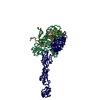
|
|---|---|
| 1 | x 60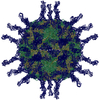
|
| 2 |
|
| 3 | x 5
|
| 4 | x 6
|
| 5 | 
|
| Symmetry | Point symmetry: (Hermann–Mauguin notation : 532 / Schoenflies symbol : 532 / Schoenflies symbol : I (icosahedral : I (icosahedral )) )) |
- Components
Components
| #1: Protein |  CD155 / Coordinate model: Cα atoms only CD155 / Coordinate model: Cα atoms onlyMass: 32928.160 Da / Num. of mol.: 1 / Fragment: THREE EXTRACELLULAR DOMAINS OF CD155 Source method: isolated from a genetically manipulated source Source: (gene. exp.)   Homo sapiens (human) / Cell (production host): KIDNEY CELLS / Production host: Homo sapiens (human) / Cell (production host): KIDNEY CELLS / Production host:   Homo sapiens (human) / References: UniProt: P15151 Homo sapiens (human) / References: UniProt: P15151 |
|---|---|
| #2: Protein | Mass: 31874.705 Da / Num. of mol.: 1 Source method: isolated from a genetically manipulated source Source: (gene. exp.)   Human poliovirus 1 / Genus: Enterovirus Human poliovirus 1 / Genus: Enterovirus / Species: Poliovirus / Species: Poliovirus / Cell (production host): HELA CELLS / Production host: / Cell (production host): HELA CELLS / Production host:   Homo sapiens (human) / References: UniProt: P03300 Homo sapiens (human) / References: UniProt: P03300 |
| #3: Protein | Mass: 29664.332 Da / Num. of mol.: 1 Source method: isolated from a genetically manipulated source Source: (gene. exp.)   Human poliovirus 1 / Genus: Enterovirus Human poliovirus 1 / Genus: Enterovirus / Species: Poliovirus / Species: Poliovirus / Cell (production host): HELA CELLS / Production host: / Cell (production host): HELA CELLS / Production host:   Homo sapiens (human) / References: UniProt: P03300 Homo sapiens (human) / References: UniProt: P03300 |
| #4: Protein | Mass: 26235.115 Da / Num. of mol.: 1 Source method: isolated from a genetically manipulated source Source: (gene. exp.)   Human poliovirus 1 / Genus: Enterovirus Human poliovirus 1 / Genus: Enterovirus / Species: Poliovirus / Species: Poliovirus / Cell (production host): HELA CELLS / Production host: / Cell (production host): HELA CELLS / Production host:   Homo sapiens (human) / References: UniProt: P03300 Homo sapiens (human) / References: UniProt: P03300 |
| #5: Protein | Mass: 6983.754 Da / Num. of mol.: 1 / Fragment: POLIOVIRUS FRAGMENTS VP1,VP2,VP3,VP4 Source method: isolated from a genetically manipulated source Source: (gene. exp.)   Human poliovirus 1 / Genus: Enterovirus Human poliovirus 1 / Genus: Enterovirus / Species: Poliovirus / Species: Poliovirus / Cell (production host): HELA CELLS / Production host: / Cell (production host): HELA CELLS / Production host:   Homo sapiens (human) / References: UniProt: P03300*PLUS Homo sapiens (human) / References: UniProt: P03300*PLUS |
-Experimental details
-Experiment
| Experiment | Method:  ELECTRON MICROSCOPY ELECTRON MICROSCOPY |
|---|---|
| EM experiment | Aggregation state: PARTICLE / 3D reconstruction method:  single particle reconstruction single particle reconstruction |
- Sample preparation
Sample preparation
| Component | Name: human poliovirus(serotype 1)complexed with three domain CD155 Type: COMPLEX |
|---|---|
| Buffer solution | pH: 7.5 |
| Specimen | Embedding applied: NO / Shadowing applied: NO / Staining applied : NO / Vitrification applied : NO / Vitrification applied : YES : YES |
Vitrification | Details: POLIOVIRUS WAS INCUBATED WITH CD155-AP FOR 1 HOURS AT 4 DEGREES CELSIUS (277 KELVIN) USING A EIGHT-FOLD EXCESS OF CD155-AP FOR EACH OF THE SIXTY POSSIBLE BINDING SITES PER VIRION. AFTER ...Details: POLIOVIRUS WAS INCUBATED WITH CD155-AP FOR 1 HOURS AT 4 DEGREES CELSIUS (277 KELVIN) USING A EIGHT-FOLD EXCESS OF CD155-AP FOR EACH OF THE SIXTY POSSIBLE BINDING SITES PER VIRION. AFTER INCUBATION, SAMPLES WERE PREPARED AS THIN LAYERS OF VITREOUS ICE AND MAINTAINED AT NEAR LIQUID NITROGEN TEMPERATURE IN THE ELECTRON MICROSCOPE WITH A GATAN 626 CRYOTRANSFER HOLDER. |
Crystal grow | pH: 7.5 Details: WARNING: THIS IS AN ELECTRON MICROSCOPY MODEL DEPOSITION. CRYO-EM INFORMATION HAS BEEN INCLUDED IN THE FORM OF REMARK 250 RECORDS AT THE TOP OF THE PDB COORDINATE FILE., pH 7.5, ELECTRON ...Details: WARNING: THIS IS AN ELECTRON MICROSCOPY MODEL DEPOSITION. CRYO-EM INFORMATION HAS BEEN INCLUDED IN THE FORM OF REMARK 250 RECORDS AT THE TOP OF THE PDB COORDINATE FILE., pH 7.5, ELECTRON MICROSCOPY RECONSTRUCTION |
| Crystal grow | *PLUS Method: unknown / Details: electron microscopy |
- Electron microscopy imaging
Electron microscopy imaging
| Microscopy | Model: FEI/PHILIPS CM200FEG / Date: Jun 1, 1999 |
|---|---|
| Electron gun | Electron source : :  FIELD EMISSION GUN / Accelerating voltage: 80 kV / Illumination mode: FLOOD BEAM FIELD EMISSION GUN / Accelerating voltage: 80 kV / Illumination mode: FLOOD BEAM |
| Electron lens | Mode: BRIGHT FIELD Bright-field microscopy / Nominal magnification: 38000 X / Nominal defocus max: 2100 nm / Nominal defocus min: 1300 nm Bright-field microscopy / Nominal magnification: 38000 X / Nominal defocus max: 2100 nm / Nominal defocus min: 1300 nm |
| Specimen holder | Temperature: 120 K |
| Image recording | Electron dose: 20 e/Å2 / Film or detector model: KODAK SO-163 FILM |
- Processing
Processing
| EM software | Name: PURDUE PROGRAMS / Category: 3D reconstruction | ||||||||||||
|---|---|---|---|---|---|---|---|---|---|---|---|---|---|
| Symmetry | Point symmetry : I (icosahedral : I (icosahedral ) ) | ||||||||||||
3D reconstruction | Method: COMMON-LINES AND POLAR-FOURIER-TRANSFORM FULLER ET AL. 1996, J.STRUC.BIOL.c 116, 48-55; BAKER AND CHENG, 1996, J.STRUC.BIOL. 116, 120-130 Resolution: 22 Å / Resolution method: OTHER / Num. of particles: 1156 / Actual pixel size: 3.68 Å Magnification calibration: THE PIXEL SIZE OF THE CRYO-EM MAP WAS CALIBRATED AGAINST A LOW RESOLUTION DENSITY MAP CALCULATED FROM THE CRYSTAL STRUCTURE OF POLIOVIRUS. DENSITIES WERE COMPARED BY CROSS- ...Magnification calibration: THE PIXEL SIZE OF THE CRYO-EM MAP WAS CALIBRATED AGAINST A LOW RESOLUTION DENSITY MAP CALCULATED FROM THE CRYSTAL STRUCTURE OF POLIOVIRUS. DENSITIES WERE COMPARED BY CROSS- CORRELATION WITHIN A SPHERICAL SHELL OF INTERNAL RADIUS 110 ANGSTROMS AND EXTERNAL RADIUS OF 145 ANGSTROMS. Details: THE RESOLUTION OF THE FINAL RECONSTRUCTED DENSITY WAS DETERMINED TO BE AT LEAST 22 ANGSTROMS, AS MEASURED BY RANDOMLY SPLITTING THE PARTICLES INTO TWO SETS AND COMPARING STRUCTURE FACTORS ...Details: THE RESOLUTION OF THE FINAL RECONSTRUCTED DENSITY WAS DETERMINED TO BE AT LEAST 22 ANGSTROMS, AS MEASURED BY RANDOMLY SPLITTING THE PARTICLES INTO TWO SETS AND COMPARING STRUCTURE FACTORS OBTAINED FROM SEPARATE RECONSTRUCTIONS (BAKER ET AL. 1991, BIOPHYS.J. 60, 1445-1456). THE EIGENVALUE SPECTRUM GAVE AN INDICATION OF THE RANDOMNESS OF THE DATA THAT WAS INCLUDED IN THE RECONSTRUCTION. THE COMPLETENESS OF THE DATA WAS VERIFIED IN THAT ALL EIGENVALUES EXCEEDED 1.0. Symmetry type: POINT | ||||||||||||
| Atomic model building | Protocol: OTHER / Space: REAL / Target criteria: VISUAL AGREEMENT Details: METHOD--MANUAL REFINEMENT PROTOCOL--MANUAL ADJUSTMENT DETAILS--THE CRYSTAL STRUCTURE OF POLIOVIRUS WAS PLACED INTO THE CALIBRATED CRYO-EM DENSITY MAP BY ALIGNING THE ICOSAHEDRAL SYMMETRY ...Details: METHOD--MANUAL REFINEMENT PROTOCOL--MANUAL ADJUSTMENT DETAILS--THE CRYSTAL STRUCTURE OF POLIOVIRUS WAS PLACED INTO THE CALIBRATED CRYO-EM DENSITY MAP BY ALIGNING THE ICOSAHEDRAL SYMMETRY AXES. APPROPRIATELY GLYCOSYLATED MODELS OF CD155 WITH VARIOUS INTERDOMAIN ANGLES WERE MANUALLY FITTED INTO THE DIFFERENCE DENSITY CALCULAT BY SUBSTRACTING POLIOVIRUS NATIVE RECONSTRUCTION FROM THE COMPLEX RECONSTRUCTION. THE COORDINATES ARE IN THE P, Q, R FRAME IN ANGSTROM UNITS AND CORRESPOND TO ICOSAHEDRAL SYMMETRY AXES. THE ORIGIN IS CHOSEN AT THE CENTER OF THE VIRUS WITH P, Q AND R ALONG MUTUALLY PERPENDICULAR TWO-FOLD AXES OF THE ICOSAHEDRON. THEY SHOULD REMAIN IN THAT FRAME FOR THE EASE OF THE USER IN CREATING THE BIOLOGICALLY SIGNIFICANT VIRAL COMPLEX PARTICLE USING THE 60 ICOSAHEDRAL SYMMETRY OPERATORS. CD155 MODEL BUILDING (D1-D2-D3)-- ATOMIC MODEL OF D1 WAS BUILT BASED ON MYELIN PROTEIN ZERO(1NEU). ATOMIC MODEL OF D2 WAS BUILT FROM A FAB FRAGMENT(1CIC).ATOMIC MODEL OF D3 WAS BUILT FROM AN INSECT IMMUNE PROTEIN(1BIH).THE ELBOW ANGLE BETWEEN D1 AND D2 WAS DETERMINED BY LEAST-SQUARE-FITTING THESE TWO DOMAINS THE CRYSTAL STRUCTURE OF CD2(1HNF). | ||||||||||||
| Refinement | Highest resolution: 22 Å | ||||||||||||
| Refinement step | Cycle: LAST / Highest resolution: 22 Å
|
 Movie
Movie Controller
Controller






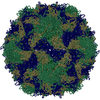
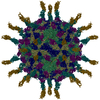
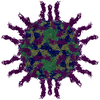


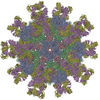

 PDBj
PDBj





